Abstract
Duodenogastric reflux is a naturally occurring sporadic event, the incidence, occurrence, and detrimental effects of which have been difficult to assess. The reliability of 24-hour gastric pH monitoring to detect duodenogastric reflux was studied. Central to the use of pH monitoring for this purpose is confidence in its ability to measure and display pH data in a way that reflects changes in the gastric pH environment with sufficient sensitivity. To test this the gastric pH of 10 dogs was measured in the fasting state, after feeding, and after pentagastrin stimulation. The antrum was more alkaline in the fasting state (p less than 0.01) and the display of data by frequency distribution graph was sensitive enough to reflect induced pH changes. To test the consistency of gastric pH at a given position, simultaneous 24-hour gastric monitoring was performed in 12 normal subjects with two probes placed at either 5 or 10 cm below the lower esophageal sphincter. Only at the 5-cm position did the two probes read within 1 pH unit of each other more than 90% of the time. Based on these principles, gastric pH monitoring was performed 5 cm below the lower esophageal sphincter in 30 normal subjects and 11 patients, fulfilling Ritchie's clinical criteria for pathologic duodenogastric reflux. The data obtained was arranged into 71 variables and subjected to discriminant analysis. Sixteen variables were identified, each with a corresponding coefficient to be used as a multiplier to derive a score. A score of more than +2.2 indicated a high probability of pathologic duodenogastric reflux. The test was applied to a validation population consisting of 10 additional normal subjects and 10 patients meeting Ritchie's criteria. All normal subjects had a normal score and all but one (90%) of the patients had an abnormal score. When compared to O-diisopropyl iminodiacetic acid (DISIDA) scintigraphy in another group of 22 normal subjects and 60 patients, 24-hour gastric pH monitoring was superior in the detection of pathologic duodenogastric reflux. The study shows how the application of computer technology can be used to diagnose pathologic duodenogastric reflux in patients with complex foregut complaints.
Full text
PDF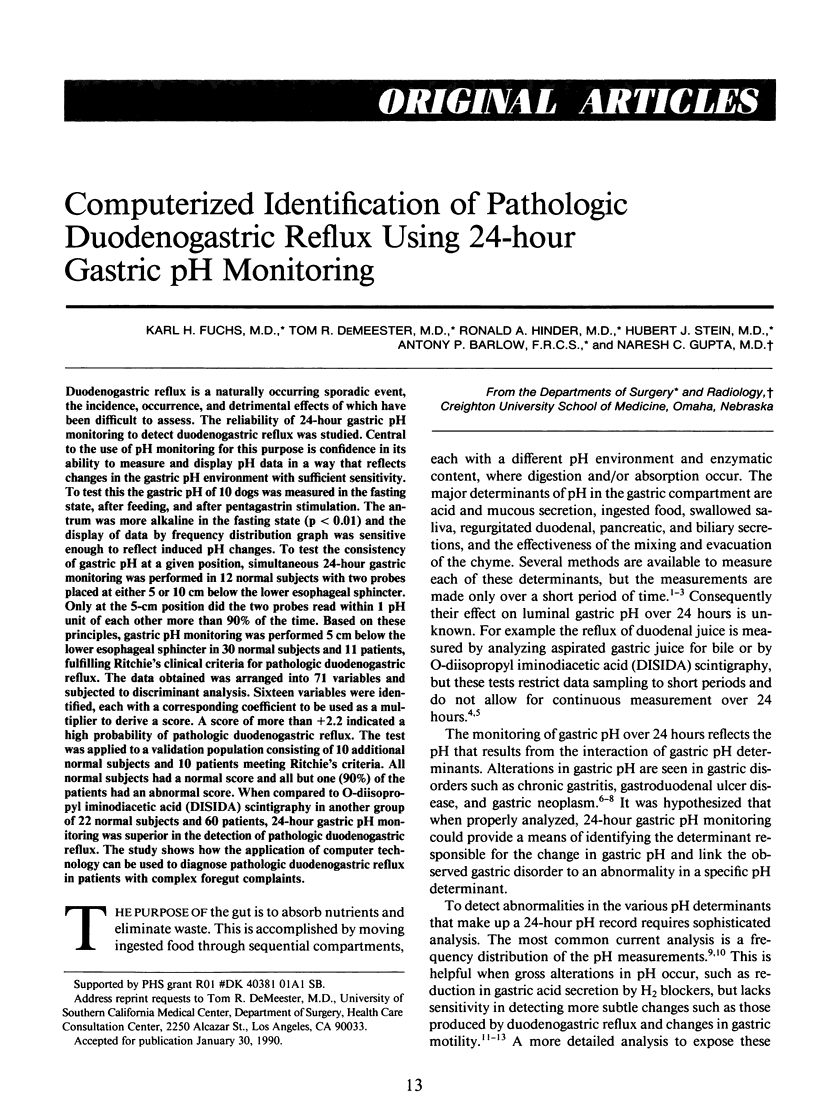
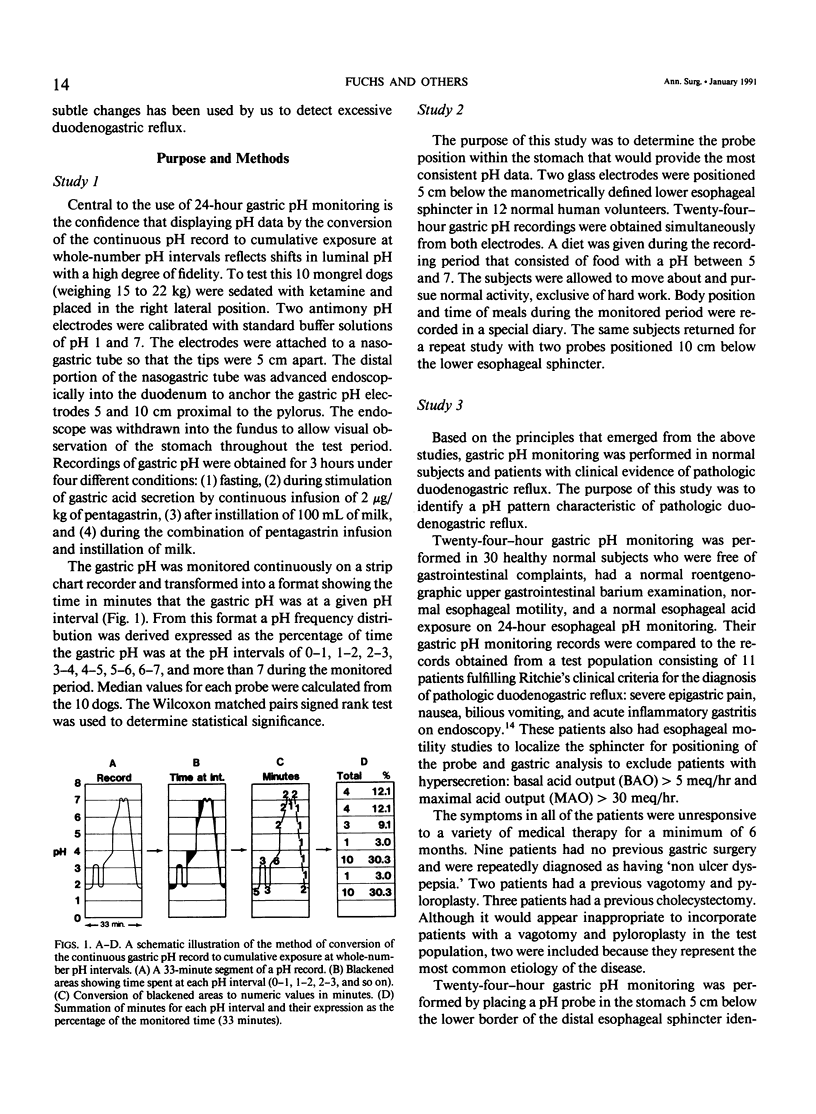
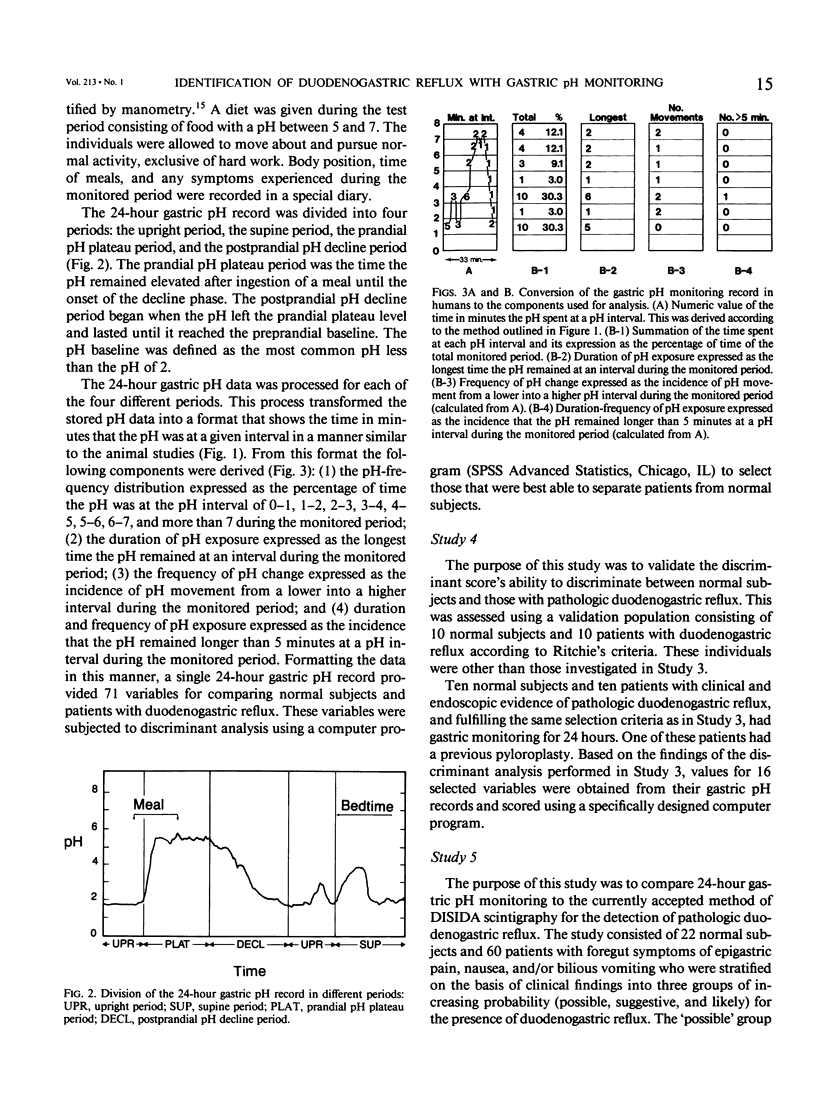
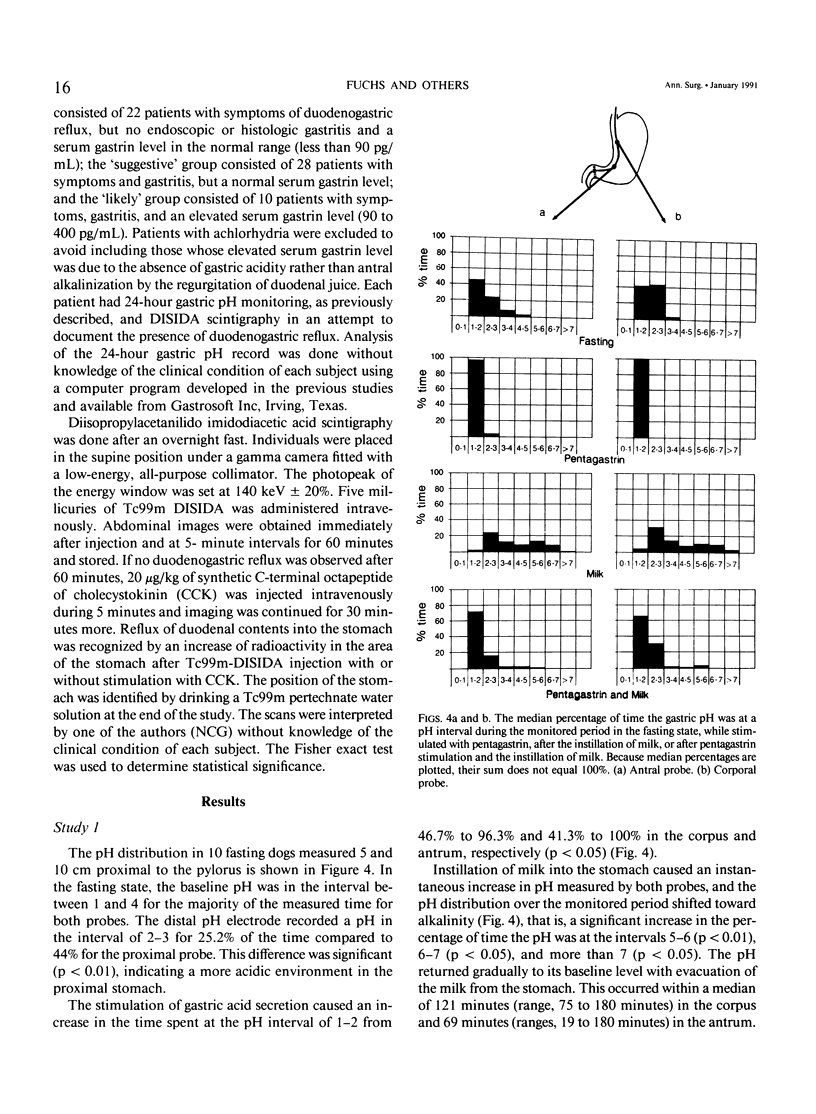
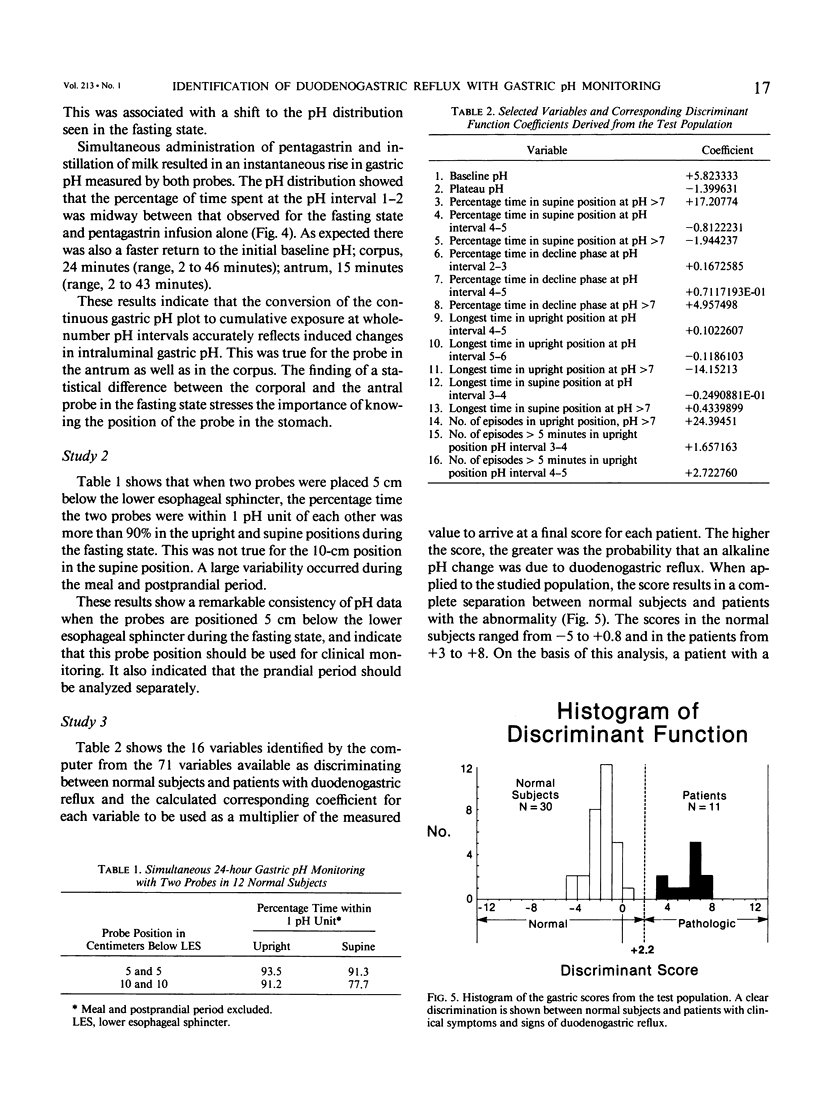
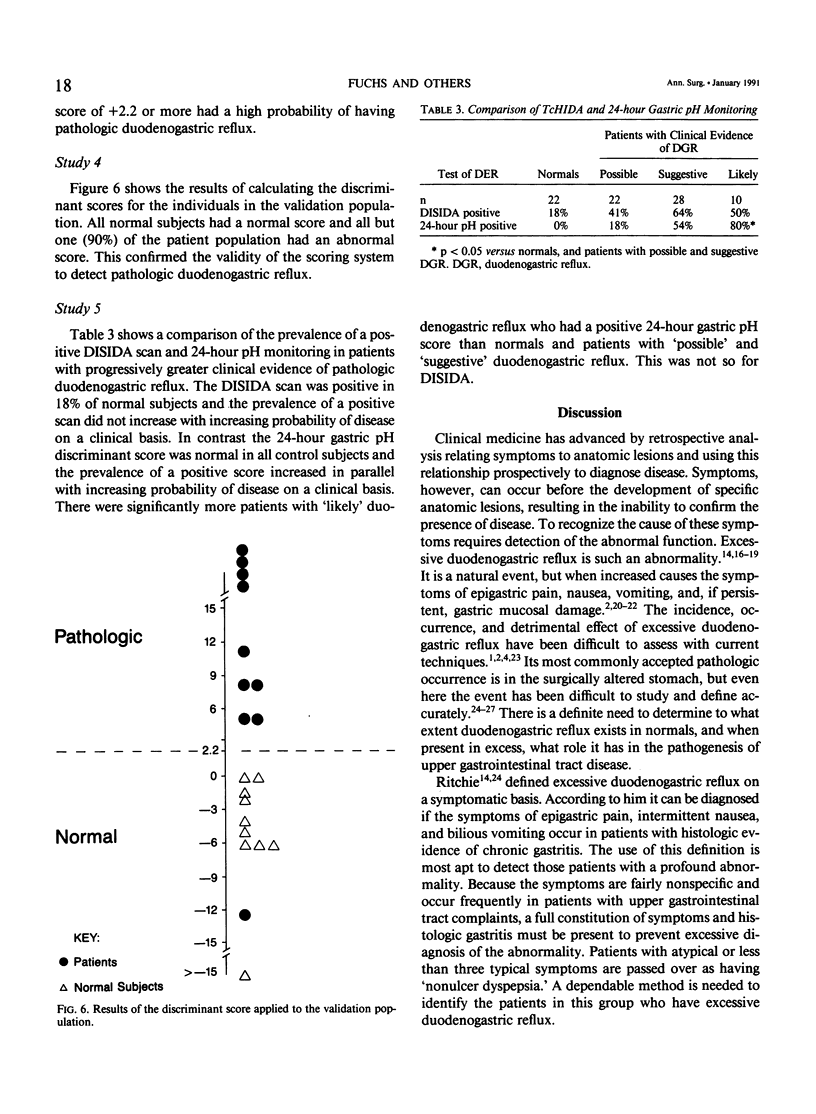
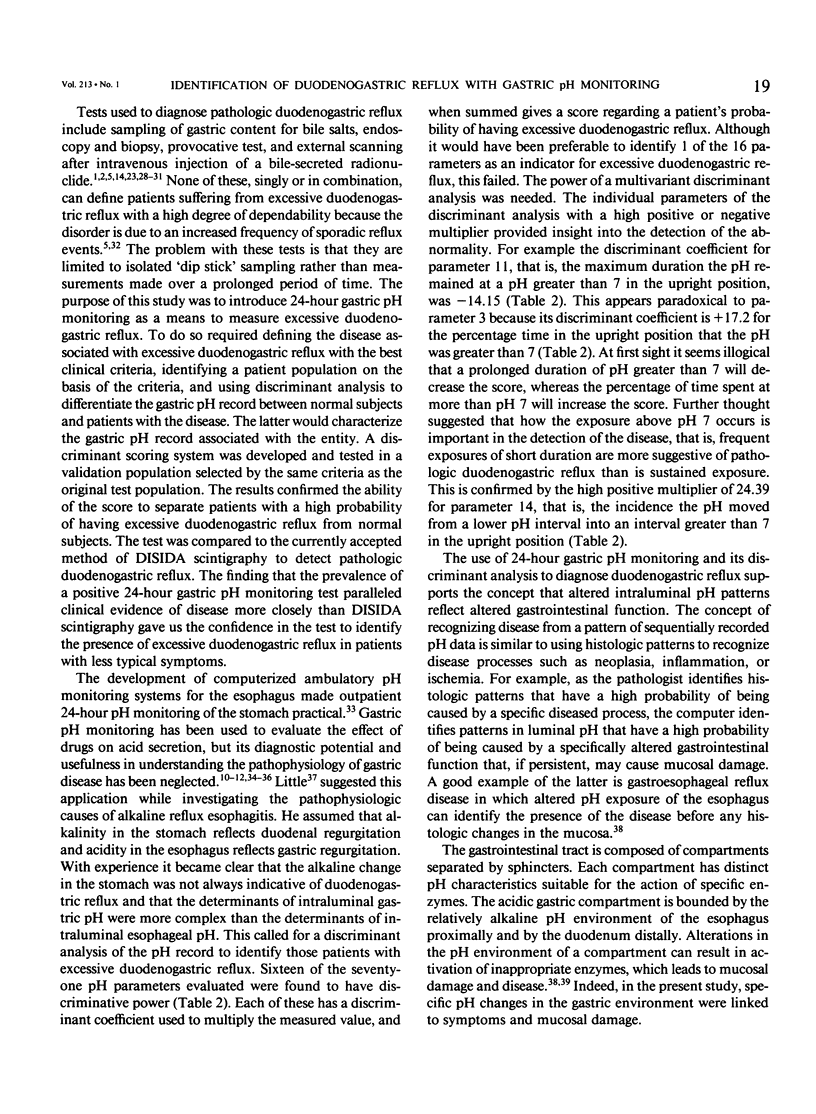
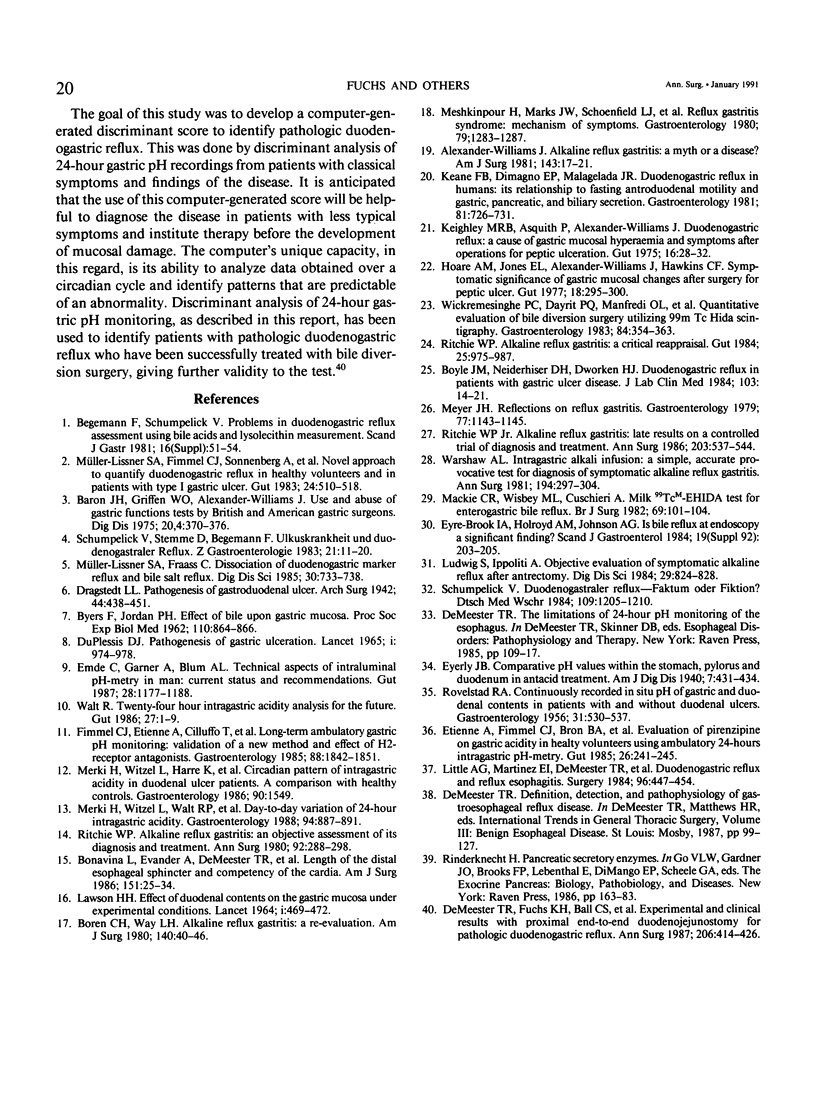
Selected References
These references are in PubMed. This may not be the complete list of references from this article.
- Alexander-Williams J. Alkaline reflux gastritis: a myth or a disease? Am J Surg. 1982 Jan;143(1):17–21. doi: 10.1016/0002-9610(82)90123-4. [DOI] [PubMed] [Google Scholar]
- Baron J. H., Griffen W. O., Jr, Alexander-Williams J. Use and abuse of gastric function tests by British and American gastric surgeons. Am J Dig Dis. 1975 Apr;20(4):370–376. doi: 10.1007/BF01237796. [DOI] [PubMed] [Google Scholar]
- Begemann F., Schumpelick V. Problems in duodenogastric reflux assessment, using bile acid and lysolecithin measurement. Scand J Gastroenterol Suppl. 1981;67:51–53. [PubMed] [Google Scholar]
- Bonavina L., Evander A., DeMeester T. R., Walther B., Cheng S. C., Palazzo L., Concannon J. L. Length of the distal esophageal sphincter and competency of the cardia. Am J Surg. 1986 Jan;151(1):25–34. doi: 10.1016/0002-9610(86)90007-3. [DOI] [PubMed] [Google Scholar]
- Boren C. H., Way L. W. Alkaline reflux gastritis: a reevaluation. Am J Surg. 1980 Jul;140(1):40–46. doi: 10.1016/0002-9610(80)90415-8. [DOI] [PubMed] [Google Scholar]
- Boyle J. M., Neiderhiser D. H., Dworken H. J. Duodenogastric reflux in patients with gastric ulcer disease. J Lab Clin Med. 1984 Jan;103(1):14–21. [PubMed] [Google Scholar]
- DUPLESSIS D. J. PATHOGENESIS OF GASTRIC ULCERATION. Lancet. 1965 May 8;1(7393):974–978. doi: 10.1016/s0140-6736(65)91214-6. [DOI] [PubMed] [Google Scholar]
- DeMeester T. R., Fuchs K. H., Ball C. S., Albertucci M., Smyrk T. C., Marcus J. N. Experimental and clinical results with proximal end-to-end duodenojejunostomy for pathologic duodenogastric reflux. Ann Surg. 1987 Oct;206(4):414–426. doi: 10.1097/00000658-198710000-00003. [DOI] [PMC free article] [PubMed] [Google Scholar]
- Emde C., Garner A., Blum A. L. Technical aspects of intraluminal pH-metry in man: current status and recommendations. Gut. 1987 Sep;28(9):1177–1188. doi: 10.1136/gut.28.9.1177. [DOI] [PMC free article] [PubMed] [Google Scholar]
- Etienne A., Fimmel C. J., Bron B. A., Loizeau E., Blum A. L. Evaluation of pirenzepine on gastric acidity in healthy volunteers using ambulatory 24 hour intragastric pH-monitoring. Gut. 1985 Mar;26(3):241–245. doi: 10.1136/gut.26.3.241. [DOI] [PMC free article] [PubMed] [Google Scholar]
- Eyre-Brook I. A., Holroyd A. M., Johnson A. G. Is bile reflux at endoscopy a significant finding? Scand J Gastroenterol Suppl. 1984;92:203–205. [PubMed] [Google Scholar]
- Fimmel C. J., Etienne A., Cilluffo T., von Ritter C., Gasser T., Rey J. P., Caradonna-Moscatelli P., Sabbatini F., Pace F., Bühler H. W. Long-term ambulatory gastric pH monitoring: validation of a new method and effect of H2-antagonists. Gastroenterology. 1985 Jun;88(6):1842–1851. doi: 10.1016/0016-5085(85)90009-5. [DOI] [PubMed] [Google Scholar]
- Hoare A. M., Jones E. L., Alexander-Williams J., Hawkins C. F. Symptomatic significance of gastric mucosal changes after surgery for peptic ulcer. Gut. 1977 Apr;18(4):295–300. doi: 10.1136/gut.18.4.295. [DOI] [PMC free article] [PubMed] [Google Scholar]
- Keane F. B., Dimagno E. P., Malagelada J. R. Duodenogastric reflux in humans: its relationship to fasting antroduodenal motility and gastric, pancreatic, and biliary secretion. Gastroenterology. 1981 Oct;81(4):726–731. [PubMed] [Google Scholar]
- Keighley M. R., Asquith P., Alexander-Williams J. Duodenogastric reflux: a cause of gastric mucosal hyperaemia and symptoms after operations for peptic ulceration. Gut. 1975 Jan;16(1):28–32. doi: 10.1136/gut.16.1.28. [DOI] [PMC free article] [PubMed] [Google Scholar]
- LAWSON H. H. EFFECT OF DUODENAL CONTENTS ON THE GASTRIC MUCOSA UNDER EXPERIMENTAL CONDITIONS. Lancet. 1964 Feb 29;1(7331):469–472. doi: 10.1016/s0140-6736(64)90800-1. [DOI] [PubMed] [Google Scholar]
- Little A. G., Martinez E. I., DeMeester T. R., Blough R. M., Skinner D. B. Duodenogastric reflux and reflux esophagitis. Surgery. 1984 Aug;96(2):447–454. [PubMed] [Google Scholar]
- Ludwig S., Ippoliti A. Objective evaluation of symptomatic alkaline reflux after antrectomy. Dig Dis Sci. 1984 Sep;29(9):824–828. doi: 10.1007/BF01318425. [DOI] [PubMed] [Google Scholar]
- Mackie C. R., Wisbey M. L., Cuschieri A. Milk 99Tcm-EHIDA test for enterogastric bile reflux. Br J Surg. 1982 Feb;69(2):101–104. doi: 10.1002/bjs.1800690215. [DOI] [PubMed] [Google Scholar]
- Merki H. S., Witzel L., Walt R. P., Cohnen E., Harre K., Heim J., Mappes A., Röhmel J. Day-to-day variation of 24-hour intragastric acidity. Gastroenterology. 1988 Apr;94(4):887–891. doi: 10.1016/0016-5085(88)90543-4. [DOI] [PubMed] [Google Scholar]
- Meshkinpour H., Marks J. W., Schoenfield L. J., Bonnoris G. G., Carter S. Reflux gastritis syndrome: mechanism of symptoms. Gastroenterology. 1980 Dec;79(6):1283–1287. [PubMed] [Google Scholar]
- Meyer J. H. Reflections on reflux gastritis. Gastroenterology. 1979 Nov;77(5):1143–1145. [PubMed] [Google Scholar]
- Müller-Lissner S. A., Fimmel C. J., Sonnenberg A., Will N., Müller-Duysing W., Heinzel F., Müller R., Blum A. L. Novel approach to quantify duodenogastric reflux in healthy volunteers and in patients with type I gastric ulcer. Gut. 1983 Jun;24(6):510–518. doi: 10.1136/gut.24.6.510. [DOI] [PMC free article] [PubMed] [Google Scholar]
- Müller-Lissner S. A., Fraass C. Dissociation of duodenogastric marker reflux and bile salt reflux. Dig Dis Sci. 1985 Aug;30(8):733–738. doi: 10.1007/BF01320486. [DOI] [PubMed] [Google Scholar]
- ROVELSTAD R. A. Continuously recorded in situ pH of gastric and duodenal contents in patients with and without duodenal ulcers. Gastroenterology. 1956 Nov;31(5):530–537. [PubMed] [Google Scholar]
- Ritchie W. P. Alkaline reflux gastritis: a critical reappraisal. Gut. 1984 Sep;25(9):975–987. doi: 10.1136/gut.25.9.975. [DOI] [PMC free article] [PubMed] [Google Scholar]
- Ritchie W. P., Jr Alkaline reflux gastritis. An objective assessment of its diagnosis and treatment. Ann Surg. 1980 Sep;192(3):288–298. doi: 10.1097/00000658-198009000-00003. [DOI] [PMC free article] [PubMed] [Google Scholar]
- Ritchie W. P., Jr Alkaline reflux gastritis. Late results on a controlled trial of diagnosis and treatment. Ann Surg. 1986 May;203(5):537–544. doi: 10.1097/00000658-198605000-00014. [DOI] [PMC free article] [PubMed] [Google Scholar]
- Schumpelick V. Duodenogastraler Reflux--Faktum oder Fiktion? Dtsch Med Wochenschr. 1984 Aug 3;109(31-32):1205–1210. doi: 10.1055/s-2008-1069351. [DOI] [PubMed] [Google Scholar]
- Schumpelick V., Stemme D., Begemann F. Ulkuskrankheit und duodenogastraler Reflux. Z Gastroenterol. 1983 Jan;21(1):11–20. [PubMed] [Google Scholar]
- Walt R. Twenty four hour intragastric acidity analysis for the future. Gut. 1986 Jan;27(1):1–9. doi: 10.1136/gut.27.1.1. [DOI] [PMC free article] [PubMed] [Google Scholar]
- Warshaw A. L. Intragastric alkali infusion: a simple, accurate provocative test for diagnosis of symptomatic alkaline reflux gastritis. Ann Surg. 1981 Sep;194(3):297–304. doi: 10.1097/00000658-198109000-00007. [DOI] [PMC free article] [PubMed] [Google Scholar]
- Wickremesinghe P. C., Dayrit P. Q., Manfredi O. L., Fazio R. A., Fagel V. L. Quantitative evaluation of bile diversion surgery utilizing 99mTc HIDA scintigraphy. Gastroenterology. 1983 Feb;84(2):354–363. [PubMed] [Google Scholar]


